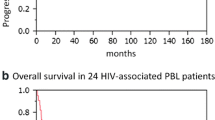Abstract
The incidence of therapy-related myelodysplastic syndromes (t-MDS) has been increasing with the widespread use of highly active antiretroviral therapy (HAART) therapy for HIV and chemotherapy for AIDS-related cancers. The classical dysplastic features in the granulocytes and megakaryocytes may not be easily appreciated. The most reliable distinguishing feature between the hematopoietic dysplasia of t-MDS and that of HIV infection rests on the identification of MDS-related cytogenetic aberrations. Here we report a patient with well-controlled HIV and history of chemotherapy for invasive anal squamous cell carcinoma who developed high-risk t-MDS with complex chromosome abnormalities. Our study emphasizes the importance of diagnosis of MDS in HIV-infected patients, even in the absence of dysplasia, if there are typical cytogenetics changes of MDS. Therefore, the early diagnosis and intervention of t-MDS in HIV-positive patients are critical in the treatment of this aggressiveness disease.
Similar content being viewed by others
A 60-year-old white male presented with worsening fatigue for 2 weeks. The patient had a longstanding history of HIV infection and clinical complications of acquired immune deficiency syndrome (AIDS) including cryptococcal meningitis. He was diagnosed with invasive anal squamous cell carcinoma 6 years ago and received mitomycin and radiation therapy. His HIV infection was well controlled by highly active antiretroviral therapy (HAART) treatment. The most recent CD4 T cell count was 299/μL. Peripheral blood smear showed pancytopenia. Complete blood count (CBC): WBC 2.91 × 109/L, neutrophils 34%, lymphocytes 61%, monocytes 4%, eosinophils 1%, basophils 0%, RBC 2.81 × 1012/L, HGB 7.2 g/dL, HCT 22.5%, MCV 80.1 Fl, and PLT 14 × 109/L. Bone marrow biopsy revealed hypercellular (80% cellularity) marrow with left-shifted granulopoiesis, clusters of blasts, megakaryocytic and erythroid dysplasia (Fig. 1a: blue arrow large cells are blasts, red arrow indicates irregular nuclear dysplastic erythroid precursor; Fig. 1b: green arrow indicates dysplastic megakaryocyte, blue arrow indicates immature mononuclear cells/blasts), and reactive lymphoid aggregates. The immunostaining of CD34 highlighted interstitially increased clusters of blasts (3–4%) (Fig. 1c). Flow cytometry report revealed a 58% maturing granulocytic elements with decreased orthogonal light scatter properties (suggesting hypogranularity) and with an unusual maturation spectrum, and an increased distinct myeloblasts population with immunophenotypical aberrancy (CD34+/CD117+/CD33+/subset CD56+/CD7dim+/HLA-DR+) (Fig. 1d, highlight in red). Cytogenetic analysis found the following complex karyotype of multiples chromosome abnormalities. 43,X,-Y,-5,del(7)(q22q36),inv(12)(p13q15),der(13)del(13)(q14q34)t(5;13)(p13;q14),-17[5]/43,idem,-inv(12),+der(12)t(12;17)(p12;q21)[5]/43,idem,-inv(12),+der(12)inv(12)(p13q24.1)add(12)(p13)[5] (Fig. 1e).
The patient was diagnosed with therapy-related myelodysplasia (t-MDS) and treatment with azacitidine was initiated. The patient developed progressive pancytopenia and passed away in 3 months. Dysplastic changes to the marrow are a common finding in advanced HIV infection on HAART therapy [1]. This case represents a patient with well-controlled HIV and history of chemotherapy who developed high-risk t-MDS with complex chromosome abnormalities. The incidence of t-MDS has been increasing with the widespread use of HAART for HIV and chemotherapy for AIDS-related cancers [2, 3]. The most reliable distinguishing feature between the hematopoietic dysplasia of t-MDS and that of HIV infection rests on the identification of MDS-related cytogenetic aberrations [4, 5]. The early diagnosis and intervention of t-MDS in HIV-positive patients are critical in treatment of this aggressiveness disease.
References
Williamson BT, Leitch HA (2016) Higher risk myelodysplastic syndromes in patients with well-controlled HIV infection: clinical features, treatment, and outcome. Case Rep Hematol 2016:8502641
Fang RC, and Aboulafia DM (2016) HIV infection and myelodysplastic syndrome/acute myeloid leukemia. https://doi.org/10.1007/978-3-319-26857-6_10
Kaner J, Thibaud S, Sridharan A, Assal A, Polineni R et al (2016) HIV is associated with a high rate of unexplained multilineage cytopenias and portends a poor prognosis in myelodysplastic syndrome (MDS) and acute myeloid leukemia (AML). Blood 2016(128):4345
Takahashi K, Yabe M, Shapira I, Pierce S, Garcia-Manero G, Varma M (2012) Clinical and cytogenetic characteristics of myelodysplastic syndrome in patients with HIV infection. Leuk Res 36:1376–1379
Rieg S, Lubbert M, Kern WV, Timme S, Gartner F et al (2009) Myelodysplastic syndrome with complex karyotype associated with long-term highly active antiretroviral therapy. Br J Haematol 145:670–673
Author information
Authors and Affiliations
Corresponding author
Ethics declarations
Conflict of interest
The authors declare that they have no conflict of interest.
Additional information
Publisher’s note
Springer Nature remains neutral with regard to jurisdictional claims in published maps and institutional affiliations.
Rights and permissions
About this article
Cite this article
Shi, M., Hu, X. & Chen, M. Evolving myelodysplastic syndrome in an HIV patient with history of anal cancer and chemotherapy. J Hematopathol 12, 213–214 (2019). https://doi.org/10.1007/s12308-019-00373-9
Received:
Accepted:
Published:
Issue Date:
DOI: https://doi.org/10.1007/s12308-019-00373-9




